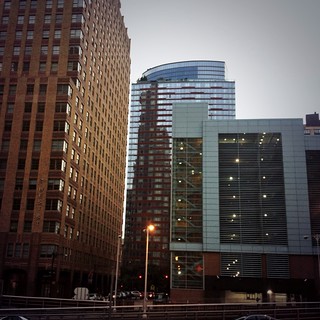Professor John An (center) and students in the bowels of the Visionaire Condominium’s black water treatment room
NYC Masters of Regional Planning students had our most exciting Infrastructure Technology class to date. We took a field trip from the AAP studio where classes are usually held, and took the # 1 subway line downtown to Battery Park City. Our target was the LEED Platinum building the Visionaire Condominium. It is the glass building in the back of the below photo.
Once we arrived at the building we went up to the 6th floor community room where we met with two guest presenters. First was Alan Cohn from the NYC Department of Environmental Protection (DEP). Alan provided us with an excellent overview of the DEP’s responsibilities and how the NYC sewer and waste water system was effected by Hurricane Sandy. One surprising fact we learned was that all 14 of NYC’s waste processing centers are located in areas vulnerable to storm surges and rising waters. During Hurricane Sandy ten were damaged, but according to Alan thirteen were back online within a week.
Following the DEP presentation, we received a presentation from Zach Gallagher, VP of Natural Systems Utilities. Zach’s firm is responsible for the black water treatment system in the Visionaire Condominium. In total, Natural Systems Utilities manages 160 such systems across North America. Their system occupies 2,000 sq. ft. of the Visionaire’s total 45,000 sq. ft. The system is located in the basement and is built directly into the building foundation.
For those who might be unfamiliar, at its most basic level a black water treatment system allows for a building’s occupants to harvest and recirculate waste water. This means that the water that went down the toilet (with you know what in it), is cleaned and used for laundry, irrigation, and building cooling. This results in a 55 percent reduction in building water consumption. Achieving such a reduction allows the building to get a 25 percent cost reduction off its NYC water and sewer fee. Annually, the water and sewer fee savings pays for the system’s operation and management. An amazing facility!
(Click the little blue bubbles for additional photos and tidbits from the excursion).


